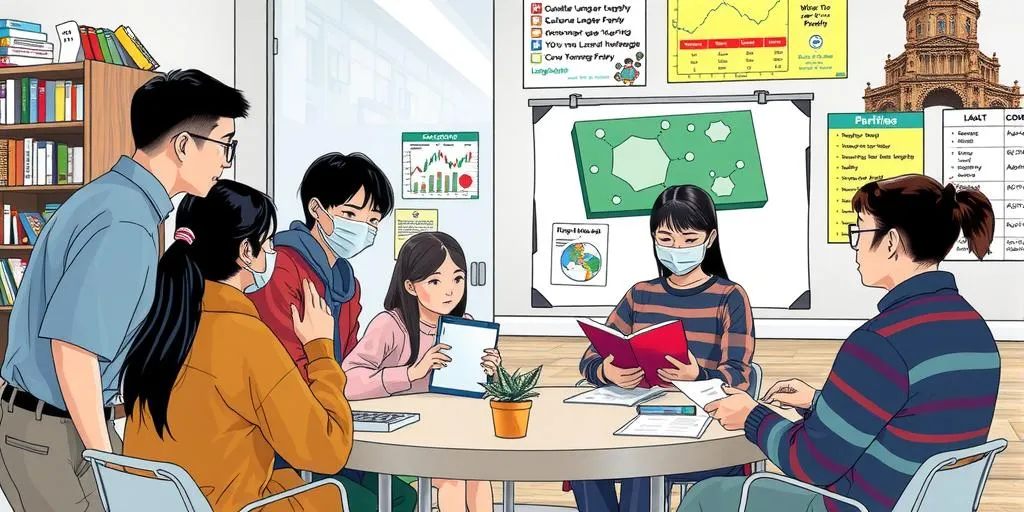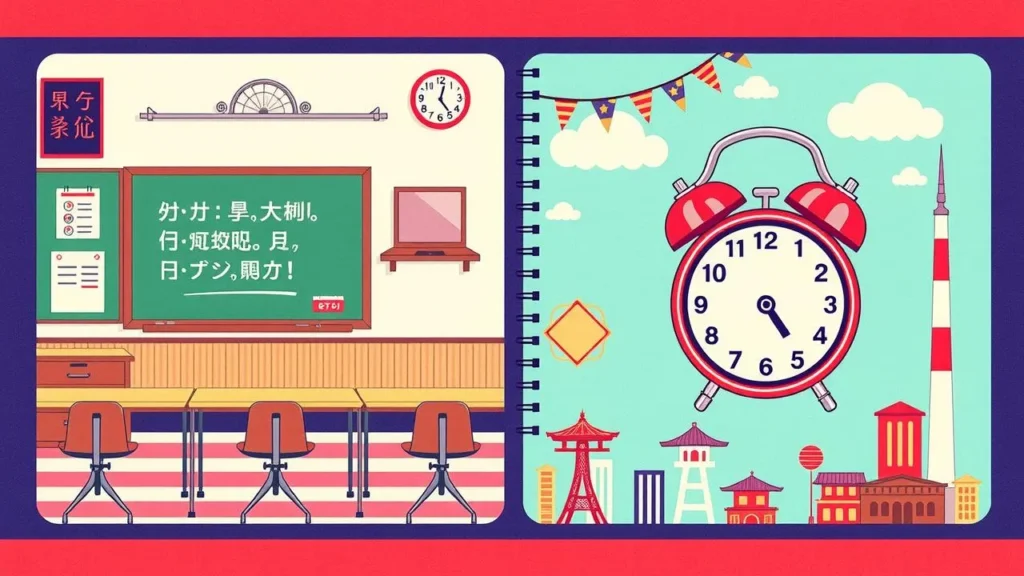Table of Contents
- Overview of Eikaiwa Teachers
- Work Hours for Eikaiwa Teachers
- Class Structure for Eikaiwa Teachers
- Flexibility in Eikaiwa Teacher Schedules
- Holiday Policies for Eikaiwa Teachers
- Overview of Assistant Language Teachers (ALTs)
- Work Hours for ALTs
- Class Structure and Responsibilities of ALTs
- Holiday Policies for ALTs
- Flexibility vs Structure: A Comparison
- Target Audience for Eikaiwa Teachers and ALTs
- Compensation Differences Between Eikaiwa Teachers and ALTs
- Frequently Asked Questions
- TL;DR
When comparing Eikaiwa teachers to ALTs in Japan, their work schedules reveal distinct differences. Eikaiwa teachers typically work part-time, often in the evenings and on weekends, catering to students’ needs after their day jobs. Their classes are usually shorter, ranging from 30 minutes to an hour, with a flexible schedule that varies weekly based on demand. In contrast, ALTs have full-time positions during regular school hours and assist with longer lessons while engaging in school activities. They enjoy a more structured routine and align their holidays with the school calendar. Ultimately, the choice between these roles depends on preferred flexibility versus stability in one’s schedule.
1. Overview of Eikaiwa Teachers
Eikaiwa teachers play a unique role in Japan’s language education scene. They often work part-time, with their schedules designed to fit around their students’ availability, which usually means evenings and weekends. This setup allows working professionals and students to attend classes after their daytime commitments. Class sessions are typically short, lasting anywhere from 30 minutes to an hour, and teachers frequently juggle multiple classes in a single day. One of the appealing aspects of this job is the flexibility it offers; however, this can also mean that work hours vary week to week based on student demand.
Unlike many jobs that provide paid holidays, Eikaiwa teachers often do not have this benefit. Their income is closely tied to the number of classes they teach, making it essential to maintain a steady flow of students to ensure financial stability. This dynamic creates an environment where teachers must adapt quickly and continuously to meet the needs of their students.
2. Work Hours for Eikaiwa Teachers

Eikaiwa teachers generally work part-time hours, which means their schedules are often in the evenings and on weekends. This timing helps accommodate students who have full-time jobs during the day. Classes tend to be short, usually lasting between 30 minutes to an hour, and teachers may have several classes lined up in a single day. Because student enrollment can fluctuate, the number of classes taught can vary significantly from week to week, offering a degree of flexibility that many find appealing. However, this flexibility comes with a trade-off: Eikaiwa teachers typically do not enjoy paid holidays, as their compensation is mainly based on the number of classes they teach. For example, if a teacher has a busy week with many students, they can earn more, but during slower weeks, their income can drop.
3. Class Structure for Eikaiwa Teachers
Eikaiwa teachers have a unique class structure designed to fit into the busy lives of their students. Classes typically last between 30 minutes to an hour, allowing for quick, focused sessions that cater to the needs of individuals or small groups. This setup is beneficial for adult learners who may have limited time due to work commitments. For example, a teacher might have back-to-back classes in the evening, teaching several different students in one night.
The flexibility of the schedule is one of the appealing aspects of being an Eikaiwa teacher. However, this also means that their hours can fluctuate significantly from week to week, depending on student demand. One week might be packed with classes, while the next could be relatively quiet. Unlike ALTs, who follow a set school calendar, Eikaiwa teachers generally do not receive paid holidays and instead earn based on the number of classes they conduct. This can lead to uncertainty in income, making it essential for Eikaiwa teachers to stay adaptable and proactive in securing their teaching hours.
4. Flexibility in Eikaiwa Teacher Schedules
Eikaiwa teachers enjoy a level of flexibility that can be quite appealing, especially for those who value a non-traditional work schedule. Typically, they work part-time hours, often focusing their classes during the evenings and weekends to fit around their students’ busy lives. Classes usually last from 30 minutes to an hour, which means a teacher can have multiple sessions in a day. This setup allows for a dynamic work environment where the schedule can shift from week to week based on student demand and enrollment. For instance, one week a teacher might have several classes lined up, while the next could be quieter, offering more free time. However, this flexibility comes with its downsides; Eikaiwa teachers generally do not receive paid holidays, and their income often depends on how many classes they can fill. As a result, while they have the freedom to choose their hours, their financial stability can fluctuate significantly.
- Varying class times throughout the week
- Potential for evening and weekend classes
- Opportunities for part-time or full-time positions
- Flexible cancellation policies for students
- Ability to adjust schedules based on personal needs
- Options for additional teaching hours or private lessons
- Variation in workload depending on season (e.g., summer programs)
5. Holiday Policies for Eikaiwa Teachers
Eikaiwa teachers face unique challenges when it comes to holiday policies. Unlike Assistant Language Teachers (ALTs), who typically enjoy paid holidays and align their breaks with the Japanese school calendar, Eikaiwa teachers usually do not receive paid time off. Their work often hinges on the number of classes they can fill, which means that during holiday seasons, such as Golden Week or summer vacations, many teachers may find their schedules significantly reduced.
For instance, if demand drops during the New Year’s holiday when many students take time off, Eikaiwa teachers might see a notable dip in their income, as their pay is often tied to the number of classes taught rather than a fixed salary. This lack of paid holidays can lead to financial uncertainty, especially for those who rely on teaching as their primary source of income. In contrast, ALTs benefit from a more stable holiday structure, making the holiday experience very different for those teaching in private language schools.
6. Overview of Assistant Language Teachers (ALTs)

Assistant Language Teachers (ALTs) play a vital role in Japan’s public school system, primarily working in elementary and junior high schools. They typically have full-time hours, which means they’re on duty about 35 to 40 hours a week, Monday through Friday. This schedule aligns well with the Japanese school day, allowing them to engage with students during regular class hours. Unlike Eikaiwa teachers, who often work evenings and weekends, ALTs benefit from a more predictable routine.
In the classroom, ALTs assist in English lessons, often working closely with Japanese teachers to enhance the learning experience. Classes can be longer, ranging from 45 to 90 minutes, and they often involve interactive activities that make learning fun. Beyond teaching, ALTs also participate in staff meetings, school events, and other activities that contribute to the school community, which adds another layer to their role.
One of the appealing aspects of being an ALT is the alignment of holidays with the Japanese school calendar. This includes long breaks during summer, winter, and spring, making it easier to plan vacations or personal projects during these times. Overall, ALTs enjoy a structured work environment that combines teaching with community engagement, providing a unique experience in Japan’s educational landscape.
7. Work Hours for ALTs
Assistant Language Teachers (ALTs) typically enjoy a more structured work schedule compared to Eikaiwa teachers. They usually work full-time hours, which means around 35 to 40 hours a week, from Monday to Friday. Their hours align with the regular school day, often starting around 8 AM and finishing by 5 PM. This means they spend their days in the classroom, assisting with English lessons and engaging with students during school activities.
The class structure for ALTs is different too. They assist in longer classes that can last anywhere from 45 to 90 minutes. This gives them time to help with lesson plans and interact with students in a meaningful way. Beyond classroom time, ALTs also attend staff meetings and participate in school events, which adds to their responsibilities and keeps their schedules full.
Another notable aspect is their holiday schedule. ALTs generally follow the Japanese school calendar, which includes extended breaks during summer, winter, and spring. So, while they have a solid routine during the school year, they also get to enjoy those long breaks. This structured routine can be appealing for those who appreciate predictability in their work life.
8. Class Structure and Responsibilities of ALTs
Assistant Language Teachers (ALTs) play a unique role within the Japanese education system. Their work hours typically span from Monday to Friday, amounting to about 35 to 40 hours each week, aligned with regular school hours. This full-time commitment allows them to immerse themselves in the school environment more thoroughly than their Eikaiwa counterparts.
When it comes to class structure, ALTs assist in English classes, collaborating with Japanese teachers to create engaging lesson plans. Classes can last anywhere from 45 to 90 minutes, providing students with ample time to practice their language skills in a supportive setting. Beyond teaching, ALTs also participate in staff meetings and school events, which fosters a sense of community within the school. This involvement goes beyond just the classroom, making their schedule more structured and predictable.
While ALTs primarily work with students in public schools, their responsibilities include adapting lessons to fit the cultural context and ensuring that learning is interactive and enjoyable. For example, they might introduce games or real-life scenarios to make language learning more relatable. This structured schedule, paired with the opportunity to engage in various school activities, contributes significantly to the overall educational experience for both ALTs and their students.
9. Holiday Policies for ALTs
Assistant Language Teachers (ALTs) generally enjoy a more structured holiday policy compared to Eikaiwa teachers. Their holidays align with the Japanese school calendar, which means they can look forward to long breaks during summer, winter, and spring. For example, ALTs typically get around six weeks off in the summer, two weeks during winter, and a week in spring. This setup allows ALTs to plan vacations or spend quality time with family and friends without the worry of losing income, as they receive a stable salary throughout the year.
In contrast, Eikaiwa teachers often do not have paid holidays, as their income is primarily based on the number of classes they teach. This can make it challenging for them to take extended breaks, as it may lead to a loss of income during those periods. Since Eikaiwa classes are more flexible and often operate outside of typical school hours, teachers might find it harder to enjoy the same kind of downtime that ALTs receive. Therefore, while ALTs benefit from a consistent holiday schedule, Eikaiwa teachers often have to navigate their time off more carefully to ensure they can maintain their income.
10. Flexibility vs Structure: A Comparison
When it comes to work schedules, Eikaiwa teachers and ALTs offer two very different experiences. Eikaiwa teachers enjoy a more flexible schedule, often working part-time hours in the evenings and on weekends. This allows them to fit their classes around their personal lives, but it also means their hours can vary widely from week to week based on student demand. For example, one week they might have a full slate of classes, while the next could be much lighter.
On the other hand, ALTs typically have a structured schedule, working full-time hours from Monday to Friday during regular school hours. Their days are more predictable, as they assist in English classes that usually last longer, ranging from 45 to 90 minutes. This structured environment means they also participate in staff meetings and school events, adding to their responsibilities but providing a clear routine.
While Eikaiwa teachers might appreciate the flexibility of choosing when they work, ALTs often benefit from the stability of their schedules, which align with the Japanese school calendar. This can be particularly appealing for those who enjoy long breaks during the summer, winter, and spring. Ultimately, the choice between the two comes down to personal preference: flexibility versus structure.
| Type | Eikaiwa Teachers | Assistant Language Teachers (ALTs) |
|---|---|---|
| Work Hours | Part-time, evenings and weekends | Full-time, 35-40 hours, Monday to Friday |
| Class Structure | 30 minutes to 1 hour, multiple classes in a day | 45 to 90 minutes, assists in lesson plans and activities |
| Flexibility | Highly variable schedules based on enrollment | More structured schedule, including meetings and events |
| Holidays | No paid holidays, work based on classes taught | Aligned with school calendar, includes long breaks |
| Target Audience | Adults and children in private settings | Public school students |
| Compensation | May earn less per hour, can work more hours based on demand | Set salary with benefits through contracts |
11. Target Audience for Eikaiwa Teachers and ALTs
Eikaiwa teachers and Assistant Language Teachers (ALTs) serve different target audiences, which significantly influences their teaching styles and interactions. Eikaiwa teachers often focus on adults or children in private settings, catering to individuals looking to improve their English skills for travel, business, or personal growth. Classes are typically tailored to meet the specific needs and goals of students, allowing for a more customized learning experience. For instance, an Eikaiwa teacher might work with a business professional on industry-specific vocabulary or with a traveler on conversational skills.
On the other hand, ALTs primarily work within the public school system, engaging with a diverse group of students from elementary to high school. Their role involves assisting Japanese teachers in English classes, which means they help deliver a more structured curriculum designed by the school. This interaction is less personalized compared to Eikaiwa, as ALTs often teach larger groups, focusing on general language skills rather than individual goals. For example, an ALT might help students practice their speaking skills during a classroom activity, but won’t have the same level of one-on-one attention that an Eikaiwa teacher might provide.
12. Compensation Differences Between Eikaiwa Teachers and ALTs
When it comes to compensation, Eikaiwa teachers and ALTs have distinct structures that reflect their different roles and responsibilities. Eikaiwa teachers often earn less per hour compared to ALTs; their pay can range from about 2,000 to 6,000 yen per hour, depending on the school and experience. However, their income can fluctuate based on class demand. For instance, if a teacher has a full schedule with several classes a day, their overall earnings can increase significantly. On the other hand, ALTs typically work under a contract that guarantees a monthly salary, often between 250,000 to 300,000 yen. This salary usually comes with benefits such as health insurance and paid holidays, which can be a considerable advantage.
The difference in pay structure also reflects the nature of their work. Eikaiwa teachers enjoy flexibility in scheduling, which can be appealing for those who prefer working part-time or wish to pursue other interests. However, without a steady paycheck, the financial stability can be less predictable. In contrast, ALTs have a more structured environment, which often leads to a consistent income, but with less flexibility in their schedule. For example, while an ALT may have to attend staff meetings or school events outside of teaching hours, their salary remains steady, regardless of the specific tasks they perform. Ultimately, the choice between the two roles will depend on personal preferences for pay stability versus scheduling flexibility.
Frequently Asked Questions
1. What does Eikaiwa stand for and what do Eikaiwa teachers do?
Eikaiwa means “English conversation” in Japanese, and Eikaiwa teachers help students improve their English speaking skills. They typically work in private language schools and offer lessons that focus on conversation and practical language use.
2. What is an ALT, and what is their role in Japanese schools?
ALT stands for “Assistant Language Teacher.” ALTs work in public schools in Japan to support Japanese teachers in teaching English. They help with lessons, activities, and often engage students in conversation to improve their language skills.
3. How do the work schedules for Eikaiwa teachers and ALTs differ?
Eikaiwa teachers often have evening and weekend classes, while ALTs usually work standard school hours from Monday to Friday during the day. This means Eikaiwa teachers might have more flexible but unconventional hours.
4. Do Eikaiwa teachers and ALTs have similar benefits and working conditions?
Not really. Eikaiwa teachers may have a less structured environment but can experience less job security. On the other hand, ALTs typically have a more stable job with benefits like vacation time, but their work may be more regulated.
5. Which option is better for a person looking to teach English in Japan?
It really depends on personal preferences. If you like a more traditional school setting and consistent hours, being an ALT might be better. If you prefer working in a lively environment with flexible hours, then Eikaiwa teaching could be the way to go.
TL;DR This blog post compares the work schedules of Eikaiwa teachers and Assistant Language Teachers (ALTs) in Japan. Eikaiwa teachers typically work part-time, mainly evenings and weekends, with flexible schedules but no paid holidays. In contrast, ALTs have full-time jobs aligned with the school calendar, structured responsibilities, and predictable hours. While Eikaiwa teachers cater to private students, ALTs work in public schools with set salaries and benefits. Understanding these differences can help you choose the right teaching path in Japan.



